Restrictions, regulation hampering innovation and education in ophthalmology
A note from the editors: Richard L. Lindstrom, MD, Chief Medical Editor of Ocular Surgery News, presented the Charles D. Kelman Innovator’s Lecture at the American Society of Cataract and Refractive Surgery meeting earlier this year. In this issue of OSN, the cover story focuses on the lecture and Dr. Lindstrom’s thoughts on ophthalmology today.
My lecture is about whether there will be more Charles Kelmans in the future or whether the entrepreneur in medicine will disappear.
Questions to consider: Is the medical profession and medical industry that supports it under attack? Are conflicts of interest best avoided or best mitigated? What might be a reasonable conflict of interest policy? What is innovation, and what is the innovation cycle? Is innovation under attack? And is there hope for the future of innovation and innovators?
No doubt, physicians and the industry that supports us are under attack. You can look anywhere you want in America and see attack, attack, attack.
What, really, is the duty of a physician? For me, I have to go back to my core values. What am I grounded in? It is nice to practice ophthalmology; I get daily rewards, and sometimes I wonder if I shouldn’t just retreat to the daily joy of practice.
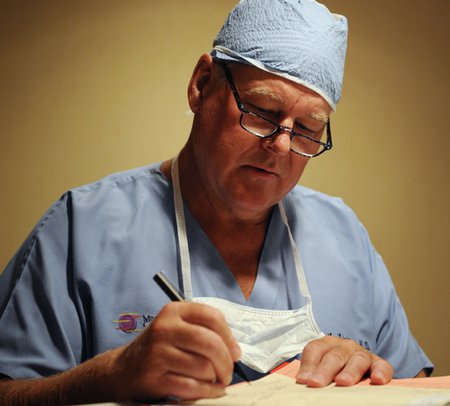 Richard L. Lindstrom, MD, puts patients at the No. 1 spot on his practice priority list. Image: Shari Fleming Photography
|
But I believe the duty of the ophthalmologist is greater than simply being an eye care provider. It includes defining the problems and unmet needs that we see in our practice every day that might help preserve, restore and enhance vision, both for the individual patient and for society as a whole. It includes developing in collaboration with others, including industry and government, solutions to these unmet needs and problems. They cannot be solved without the engagement of the individual physician and surgeon. This process requires innovation and innovators.
Also, I believe that these innovators need to disseminate the knowledge acquired to their colleagues through peer-to-peer teaching. This educational process is appropriately delivered peer-to-peer. Some people think we should have professional teachers who review the literature and simply spout the literature out to you so there will be no conflict of interest. “I’ve never done a cataract operation, but I can teach cataract surgery. I’ll just review the literature and tell you what the textbook says.” Is that the teaching that we want? I would suggest it is not. And certainly we need quality continuing medical education to deliver quality care.
Each of these duties is being threatened by external forces in our society, and I believe regulation and compliance are threatening our ability to take care of our patients in a compassionate, appropriate fashion.
Industry is stepping forward with guidelines to distinguish between appropriate interactions with us in the medical community that advance the equality of care vs. the interactions that have the potential to impact medical decision-making inappropriately. I certainly applaud that, but we as surgeons have to also make our own decisions.
Conflicts of interest
I believe conflicts of interest are unavoidable and occur every day, in every ophthalmologist’s practice. Personal interest conflicts: Are you going to go home early, or are you going to take care of that scleral laceration? Financial interest conflicts: Are you going to charge an appropriate fee that is justifiable or what the market will bear? Competing loyalties: Who are we going to be loyal to, the company making a product, the insurance company or the patient who is sitting in front of us?
These things we have to deal with every day. You cannot eliminate conflicts of interest in life, but conflicts of interest do not necessarily lead to a breach of obligation. The presence of a conflict of interest is not, in and of itself, evidence of misconduct. Some people take the position that if you have a conflict of interest, that in itself is misconduct.
That is not true and is an impossible standard to meet for everyone.
When unavoidable, conflicts of interest can be mitigated and managed, basically by doing what is in the best interest of the patient and disclosing the conflict.
In order to resolve these moral and ethical dilemmas, the inevitable conflicts of interest, we have to prioritize our stakeholders in our practice. It is pretty simple for me (Table 1).
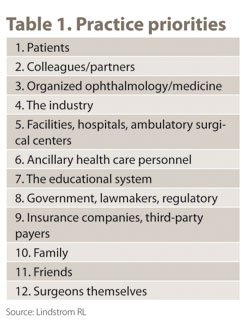 |
No. 1: What is in the best interest of patients? Is it in the best interest of patients to develop new products? Yes. Is it in the best interest of my patients to teach my colleagues how to help take care of their patients? Yes. Once in a while, I get to No. 2, which is, what is in the best interest of my colleagues and my partners? I find that most physicians are extremely altruistic and most of us put ourselves pretty far down on the list. So I do not go past two and almost never past one. Patients first.
There are conflicts of interest, and we deal with them, I believe, with honest, complete, transparent disclosure. Some people are worried about the Sunshine Act. I am not. I am fine with it. My salary was disclosed at the University of Minnesota every year I served on the full-time faculty. We already have the Sunshine Act in Minnesota. Most of my patients cannot believe how little I get paid for the time I take to consult. And most of them are quite impressed that I am good enough that someone wants me to consult. So do not fear transparency. It is not going to put you at risk as long as you are transparent and put patients first.
Conflict of interest policies are a particular concern for medical education and research. The Harvard Medical School committee says the following: “An essential principle: interactions between academia and industry are crucial to science and to facilitating the translation of knowledge from the research bench to the bedside.”
Its policy supports and encourages faculty to do the following: conduct research sponsored and supported by industry, collaborate with industry on research protocols and co-author publications derived from these collaborations, consult with industry, found biotechnology companies, license technology to or from pharmaceutical medical device and biotechnology companies, serve on scientific advisory boards of pharmaceutical device and biotechnology companies, and hold equity in pharmaceutical device and biotechnology companies.
Harvard University encourages its faculty to interact constructively and ethically with industry. Think of the quality of the faculty that it will be able to recruit as we look forward to the future.
In addition, while Harvard University acknowledges that other peer institutions have banned industry sponsorship of CME, Harvard believes that when appropriately managed, industry remains an important resource for funding of high-quality CME. For those of you who work at universities, this is a model worth emulating.
In summary, we cannot get rid of conflicts of interest, but they are manageable. “Patients first” takes me through the door almost every time. When a conflict of interest occurs, disclose it in a sincere, transparent way. Every now and then, maybe recuse yourself from participation in certain settings.
How will we know when we are getting education that is good and transparent and honest? We know. All we have to do is evaluate the audience for a perception of bias and look at the Harvard policy when you are wondering what is appropriate as a guideline.
Thoughts on innovation
What about innovation? What is innovation? It is the art of introducing something new, an idea or a method. Research is not the same as innovation. Basic science research applied to an unmet need is innovation, and the distance between research and bringing the innovation to the patient is called the “translational gap.” Innovation may be incremental or disruptive, and when it is disruptive, it often topples industry leaders.
This is a model of the innovation cycle (Figure 1): observation, invention, product development, animal experimentation, failure. Sometimes the cycle occurs again. Failure. Failure. Failure. Human data. On through the process of product development, U.S. Food and Drug Administration and global regulatory approval, and product adoption.
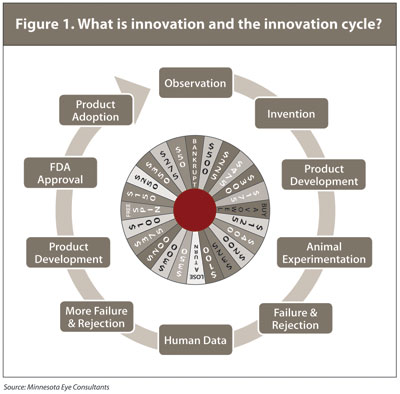 |
When I started in ophthalmology about 35 years ago, this process took 2 or 3 years. Now, it takes 10 to 12 years. It is astronomical, the cost and time it takes to traverse the innovation cycle today.
Academicians at Stanford University recently did a major study funded by the Medical Device Management Association, looking at the medical device companies’ perspective on the regulatory situation in America. As a background, the U.S. med-tech industry ships $123 billion in product outside the country; it is one of the few industries in America that has a positive balance of trade. The industry pays $21.5 billion in salaries and directly employs more than 357 million individuals, and I am concerned external forces are trying to destroy this industry.
Looking back at what used to be and what is today, we have had some great “Eureka!” moments in ophthalmology: Harold Ridley, the IOL; Gerd Meyer-Schwickerath, lasers; Charles Kelman, transforming cataract surgery. Think about cataract surgery. When I started, in the U.S. it cost $5,000 an eye, including hospital and surgeon, to take care of about 600,000 cataracts. Today, we take care of 3 million-plus cataracts for a lower cost in inflation-adjusted real dollars, and the only reason we are able to do that with fewer ophthalmologists is innovation. Innovation does not just increase cost; it often reduces cost and increases efficiency while enhancing quality of care. That is a triple win.
In the early years of my practice, an inventor went with his idea to a company, interested the company, and the company made the product. That worked for almost 40 years, and in those days, it took 2 or 3 years to bring a product to market. Then we moved to the public marketplace. The stock market was great, 1980 to 1995. In that period, most companies were founded with a small IPO. STAAR was founded with $4 million, Summit and Visx with $5 million. KeraVision required $50 million to be founded. I was part of that, creating Intacs. In the end, more than $120 million was invested in Kera-Vision, and basically it failed. It was replaced by another technology I was involved with called the excimer laser almost immediately upon approval. So not always are these great successes.
And now we are in the venture capital era, and all of these companies that you are familiar with — LenSx, Visiogen, eyeonics, IntraLase, KeraVision, Fovea, ESBATech, Eyetech, Oculex — are venture-capital funded. Some of the amounts approach $180 million to try to bring these companies’ products to market. Venture investing in the ophthalmic sector was minimal until the late 1990s, but it is now the way that things get done in our industry. The venture capital group is the only group that can afford cost and risk today to bring new technology to market. Fortunately, we in ophthalmology have attracted a lot of this investment money and we have seen a lot of devices and bio-pharma innovation. On the front of the eye, it has been mainly device; in the back of the eye, it has been primarily bio-pharma.
If you are a venture capitalist, what are you looking for? You are looking for a technology that resolves an unmet need (Table 2). Here is what the venture capitalist wants to invest in: something that will meet an unmet need, a partially met need or a problem that would ideally, if resolved, be disruptive.
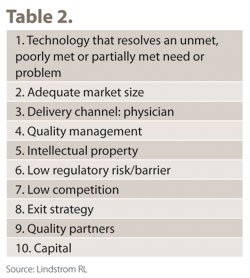 |
You have to have a big enough market to make it worth it. You need to have a delivery channel, quality management, and some form of “moat” or intellectual property to protect your investment from competitors. A low regulatory barrier is better. A lot of people are abandoning medical devices and pharma investment because the regulatory barrier is too high. Low competition would be great. You would like to have an exit strategy, for example, a strategic sale to a large company or IPO, quality partners to invest with, and capital.
It has served America well, but we have some issues.
In the 2010 Stanford University study on the FDA Impact on U.S. Medical Technology Innovation, here is the conclusion: “Unpredictable, inefficient and expensive regulatory processes are jeopardizing America’s leadership position in med-tech innovation.”
In a quote from the study, a clinical professor of surgery at Stanford University said, “In previous decades we shipped manufacturing jobs offshore. Now we’re shipping knowledge worker jobs abroad. Once you export innovation jobs, these jobs won’t come back. We need to balance adequate regulatory scrutiny with the rapidly increasing innovation cycle.”
The Europeans love what we are doing. We are helping them a ton, and I am glad my friends in Europe are doing well, but I am worried about us.
What are the top 10 factors that negatively impact medical technology development? No. 1 on nearly everyone’s list: FDA regulatory barriers.
Around 1987, we were getting about 20 drugs for $5 billion, maybe $400,000 per drug (Figure 2). In the golden era, 1997, investment was going up. Drug approvals were going up. We invested about $15 billion to get 60 new drugs. Those are the ones that we have been using and are going off patent now. But look what happened beginning around 1997. The costs continued to grow exponentially and the number of approvals declined. Now, we are at 20 drug approvals for $40 billion. That is $2 billion per approval. That suggests that, in America in 10 years, we will spend $80 billion to approve zero drugs.
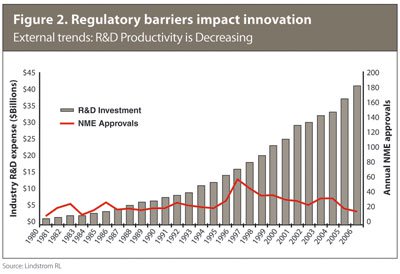 |
So what are the big pharma companies saying? “We quit.” Their boards will not allow them to invest in new molecules any longer. They are done. They are saying to venture capitalists, “You are willing to take greater risk, so please develop the next generation of new drugs for us.” But if we develop an environment in which even venture capitalists are not willing to invest, we are in trouble. We are very close to that environment today in America.
But what happens in America? We have premarket approvals (PMA) for novel, high-risk technologies and 510(k)s for low- and medium-risk technologies. This last year, we almost lost the 510(k) model approach.
Most of the time involved in bringing a new product to market in America is dealing with FDA regulatory barriers — about 80%. Most of the money is spent bringing it through the FDA — about 80%. So you spend $20 million or $30 million developing a good product, knowing that it is a good thing, and then you spend $80 million to $100 million on regulatory costs to get it through the FDA, and for a drug, maybe $1 billion.
What is it like in Europe? Are patients less safe in Europe? Do you think that the patient in Sweden or Germany is not as safe as the patient the U.S.? I travel a lot. I think their patients are plenty safe. I do not see any difference in the safety for the extra billions we spend. To get something approved on a 510(k) in the U.S. takes almost 4 years; in Europe, it takes 7 months. To get something that requires a PMA is in the range of 5 to 10 years in the U.S. and 1 year in Europe. The companies find the European regulatory agencies to be more reasonable, more predictable, more transparent and better overall. And so what do the innovators do? They go to Europe, and they do their innovation in Europe. Is that good for America? No. Is it good for Europe? Yes. But I am an American, so I want to retain innovation and jobs in our country.
Many U.S.-developed medical technologies are available outside the U.S. We all know this. That is why we go to Europe to learn new things years before they are approved in America.
The FDA suggests that it is doing a little better job than external evaluation suggests. But, basically, companies navigating the U.S. regulatory environment are incurring substantial cost to the point where some of them are starting to bail out on innovation. That is not a good thing for any of us.
So what are we doing now? We are trying to harmonize the regulatory approach used around the world, and we as a society have to decide: Should the European Union be like the U.S.A., or should the U.S.A. be like the European Union? I am not going to ask you to vote, but I am going to advocate that I would like to see the U.S.A. be more like the European Union. And I hope my colleagues in Europe fight hard that they do not get the U.S. system, because then industry and innovation and new product development will atrophy there as well.
So is the innovation cycle in America dead? No, but it is definitely depressed, and I do not think anyone who is an ophthalmologist and innovator who has worked within industry would argue.
Is anybody listening? I hope someone is listening. Innovators, physicians, industry and patients should be concerned about this trend. Definitely our government and even the FDA should be concerned.
What do we do? I think there are some really good people at the FDA. I think they need more support to do their job. But we also need legislative changes and oversight. And every now and then, we may need to do some litigation. There have been companies that have been held up so long that I believe the only route out for them probably is to litigate. Let your legislators know that innovation is a good thing, that it reduces costs, that it enhances quality of care, that it solves unmet needs, because legislation is the only way to really change this.
We are starting to see some good signs. President Barack Obama ordered federal agencies to review government regulations to determine if they hinder economic growth. Anyone who looks at it objectively will not have much trouble finding that they do. Right now, maybe we would like to have a few more jobs in America. One way would be to get some of our inappropriate regulations modified.
The FDA seems appreciative of this issue. It has launched the Medical Device Innovation Initiative, which is designed to facilitate an innovation pathway to ensure that the American patient has access to select critically important technology through priority review, strengthened research and development, development of breakthrough technology, and advancement of quality regulatory science. The FDA is tuning in. We need to encourage that because the FDA of today has become too obstructionist.
Erik Paulsen, my state representative, has introduced the Protect Medical Innovation Act. Medical innovation is very important to my state, Minnesota. The health of our economy, millions of quality high-paying jobs, and the future of medical innovation in America depends on us reviewing and reforming our regulatory process.
What I believe
I believe increasing regulatory burdens and the rapidly rising cost in both resources and time to develop a new device or drug and bring it to market are threatening the innovation cycle, and this is a potentially serious threat to the well-being of our patients, our profession, our economy in America. Other countries certainly can have the same process and, working together globally, we can improve upon our regulatory process in the next decade.
A closing thought: Ophthalmology has generated some of the leading innovators in history, including Charles Kelman. Every now and then, we physicians and surgeons ourselves have discouraged and rejected critical innovation and obstructed our colleagues in developing new products and teaching us how to apply them. I strongly suggest that it is not a good thing to obstruct or discourage innovators from trying to bring new ideas into our field and taking them from research to reality. Encourage your innovative colleagues and company entrepreneurs, do not discourage them, because they are going to help us all by developing the next generation of drugs and devices.
Do not discourage or obstruct innovators from being allowed to teach you because they have a lot to teach; yes, make them disclose their financial interests in the companies or products; and judge them on the quality of their teaching. But, I believe that you should want to learn from these innovative people, and they have much to teach you.
In conclusion, during this era of unprecedented and formidable roadblocks to innovation, I believe it is time for us as a profession, as a society — and ASCRS is the society of innovation — to take an active role in defending our ability to innovate and educate our colleagues. It seems like it should be simple; it is not.
Support innovation to preserve, restore and enhance vision for the benefit of our patients around the world. I am passionate about it. I am sorry if some of you disagree, but this is the way I feel and it is becoming a critical issue. Those of you who also believe that this is a critical issue, get involved.
![]()
Guest
Commentary
Lecture provides a
call to action for ophthalmologists
References:
- CDRH Medical Device Innovation Initiative. U.S. Food and Drug Administration website. http://www.fda.gov/AboutFDA/CentersOffices/CDRH/CDRHInnovation/default.htm.
- FDA Impact on U.S. Medical Technology Innovation. National Venture Capital Association website. http://www.nvca.org/index.php?option =com_docman&task=doc_download&gid=668&Itemid=93.
- FDA launches Medical Device Innovation Initiative. U.S. Food and Drug Administration website. http://www.fda.gov/NewsEvents/Newsroom/PressAnnouncements/ucm242629.htm.
- Harvard Medical School Faculty of Medicine Committee on Conflicts of Interest and Commitment 2009-2010 Review. Harvard Medical School website. http://hms.harvard.edu/public/coi/pdfs/2010_recommendations.pdf.
- Richard L. Lindstrom, MD, can be reached at Minnesota Eye Consultants, 9801 DuPont Ave. S, Suite 200, Bloomington, MN 55431; 952-888-5800; email: rllindstrom@mneye.com.
- Disclosure: Dr. Lindstrom provides practice management or marketing consulting services to 3D Vision Systems, Abbott Medical Optics, AcuFocus, Adoptics, Advanced Refractive Technologies, Alcon Laboratories, Aquesys, Bausch + Lomb, Biosyntrix, Bradley Scott Inc., Calhoun Vision, Clarity Ophthalmics, Clear Sight, Glaukos Corporation, High Performance Optics, Hoya Surgical Optics, LenSx, Ocular Surgery News/SLACK Incorporated, TearLabs Inc. and TLC Vision Corporation.

![]()
 Thomas W. Samuelson |
Dr. Lindstrom’s Charles D. Kelman lecture at the 2011 ASCRS meeting is must reading for those interested in the innovative process within ophthalmology. Always a forward thinker, Dr. Lindstrom candidly assesses the FDA approval process, highlighting some of the regulatory barriers that he believes inhibit innovation in the U.S. The process, while well intentioned, has become so onerous that many start-up companies buckle under the financial burden inherent to bringing a product to market. It is undeniable that the FDA has fiduciary responsibility to protect U.S. citizens from potentially harmful new technologies, yet it is vital that the process avoid overbearing and stifling regulatory burden that delays or derails entirely the approval of efficacious and safe technologies.
In my opinion, the primary responsibility of the FDA is to ensure safety of new products so that patients are not harmed. Yet the agency should be mindful that efficacy need not exceed or even match current therapies. Indeed, a safer, slightly less effective drug or device may be a welcomed treatment option. Regulators must acknowledge the limitations of current technologies. In my own corner of the ophthalmic universe, glaucoma, we have a gold standard procedure, ie, trabeculectomy, that is highly efficacious but subjects patients to a life-long risk of bleb-related endophthalmitis. We need a safer procedure to utilize in early to moderate disease. Several small companies staffed with some of the most innovative researchers in our industry are laboring furiously to gain approval. Will they be able to survive the “death by a thousand cuts” experience that has become the regulatory approval process? Dr. Lindstrom’s lecture is poignant, timely, extremely well delivered, and is must reading for the ophthalmic innovator.
– Thomas W. Samuelson, MD
OSN Glaucoma
Board Member
Disclosure: No companies or products are mentioned that would
require financial disclosure.
 John A. Hovanesian |
Physicians can no longer take a passive role in waiting for new technologies to become available. On a daily basis we face problems that have a safe, proven solution, but the solution is only available overseas. The FDA is simply too restrictive in allowing U.S. doctors access to new technologies, and we need to push back through legislators and with direct feedback to the FDA about our dissatisfaction.
Dr. Lindstrom’s lecture beautifully illustrated this problem, its growing impact on the care of our patients, and how we as physicians need to respond on their behalf.
– John A. Hovanesian, MD, FACS
OSN
Cornea/External Disease Board Member
Disclosure: No companies or products
are mentioned that would require financial disclosure.
